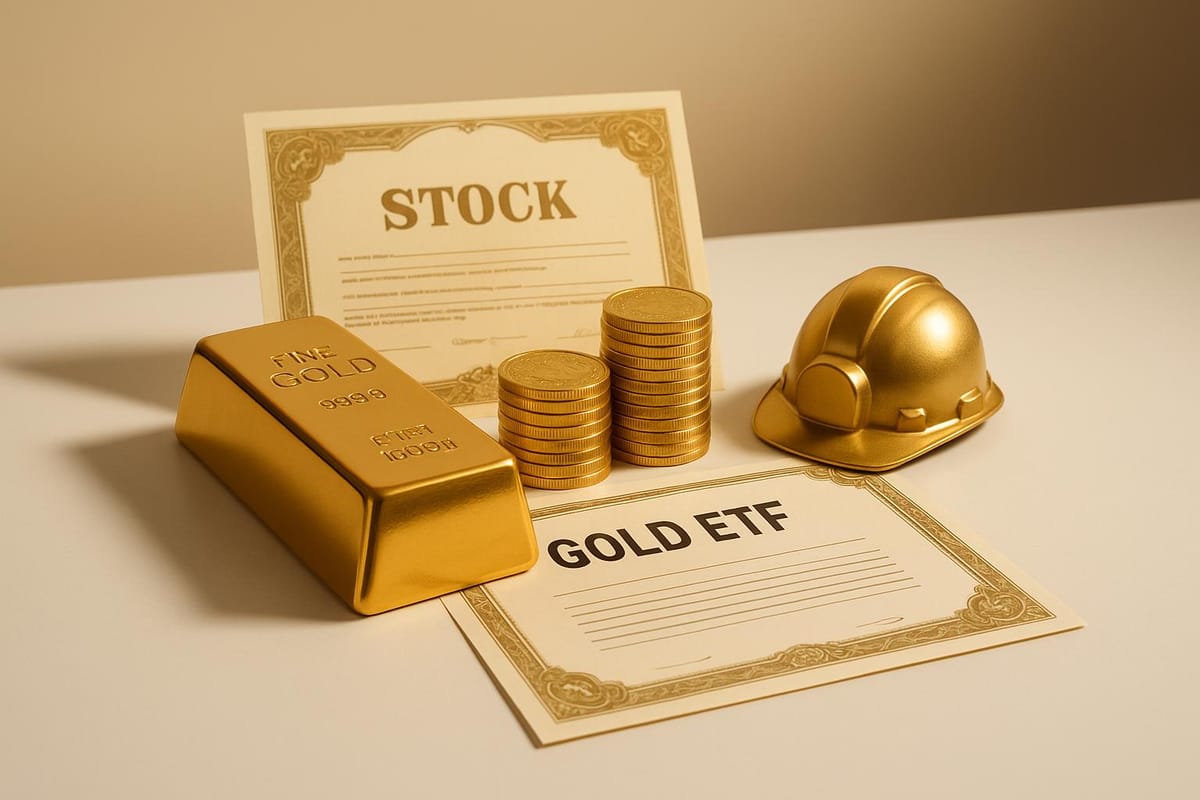5 Best Gold Investment Options for Beginners
Explore the top five gold investment options for beginners, including physical gold, ETFs, and mining stocks, to diversify and protect your wealth.

-
Physical Gold (Coins, Bars, and Jewelry)
- Pros: Tangible asset, direct ownership.
- Cons: Requires secure storage, higher transaction costs.
-
Gold Exchange-Traded Funds (ETFs)
- Pros: High liquidity, no storage hassle, low fees.
- Cons: Counterparty risk, price volatility.
-
Gold Mining Stocks
- Pros: Potential for high returns, dividends.
- Cons: High volatility, company-specific risks.
-
Gold Mutual Funds
- Pros: Professional management, diversification.
- Cons: Higher fees, less liquid than ETFs.
-
Digital Gold
- Pros: Low entry point, secure online storage, high liquidity.
- Cons: Cybersecurity risks, platform reliability concerns.
Quick Comparison
| Option | Liquidity | Storage Required | Risk Level | Cost | Best For |
|---|---|---|---|---|---|
| Physical Gold | Low | Yes | Low | High (storage, insurance) | Long-term wealth preservation |
| Gold ETFs | High | No | Medium | Low (0.3%-1% fees) | Short-term liquidity |
| Gold Mining Stocks | High | No | High | Varies | Growth potential |
| Gold Mutual Funds | Moderate | No | Medium | Higher fees (0.6%-1.2%) | Diversification |
| Digital Gold | High | No | Medium | Low (platform fees) | Small, regular investments |
Gold is a great way to diversify your portfolio, hedge against inflation, and protect wealth during uncertain times. Whether you prefer the tangibility of physical gold or the convenience of ETFs and digital gold, the right choice depends on your goals, risk tolerance, and investment timeline.
How to Invest in Gold for Beginners | Full Guide
1. Physical Gold (Coins, Bars, and Jewelry)
Investing in physical gold is one of the most traditional ways to own this precious metal. When you purchase gold coins, bars, or jewelry, you're acquiring a tangible asset - something you can physically hold. This direct ownership gives you full control over your investment, without relying on intermediaries.
Gold bullion, which includes high-purity bars and coins, is a popular choice for those who want to hold physical gold. Some well-known options include American Gold Eagles, Canadian Gold Maple Leafs, and bars from trusted refiners. These typically contain between 99.5% and 99.99% pure gold, making them highly recognizable and easy to trade with dealers worldwide.
Here’s a closer look at the key aspects of investing in physical gold.
As Ben Nadelstein, Head of Content at Monetary Metals, puts it:
"Gold is a physical asset that can be lost, stolen, or damaged. Unlike stocks and bonds, which usually exist only in digital form, gold's value is directly tied to its physical integrity. Without secure storage, investors risk losing a portion, or even all, of their investment".
Storage and Security Requirements
Owning physical gold means you’ll need to think carefully about storage and security. There are three main storage options:
- Home storage: Offers immediate access but requires a high-quality safe and confidentiality about your holdings.
- Professional vaults: Provide maximum security and charge annual fees, typically between 0.33% and 0.5% of your gold's value, which often includes insurance.
When choosing professional vaults, it's crucial to opt for allocated storage, where specific bars or coins are held in your name. Brett Elliott, Marketing Director at APMEX, explains the risks of the alternative:
"If you own allocated gold, you own specific bars or coins in your name. It's physically separate from other customer's holdings. Unallocated gold means you do not own specific bars or coins; you have a claim on a shared gold account that the vault provider can lease or trade. In bankruptcy proceedings, you could be treated as (an) unsecured creditor and lose your gold".
For example, the Texas Bullion Depository offers state-run, audited vault services for secure storage. Whichever option you choose, keep detailed records of your purchases, including invoices, receipts, and certificates of authenticity.
Liquidity
Physical gold is known for its clear value and ease of sale, though dealer commissions can affect your payout. Gold bullion is especially liquid because its value is transparent and widely recognized.
When selling, avoid pawn shops or general jewelers, as they often offer lower prices. Instead, work with specialized gold dealers who understand the market and offer competitive rates. Online buyers can sometimes provide better deals due to lower overhead costs.
Before selling, always check the spot price of gold, which fluctuates daily. For example, on May 6, 2025, the spot price was $109.12 per gram, $109,117.10 per kilogram, or $3,394 per ounce. Richard Weaver, President of the Professional Numismatists Guild, advises:
"Know the current spot price of the precious metal you want to buy or sell".
Keep in mind, though, that you won’t receive the exact spot price due to dealer fees and spreads. Companies like Abe Mor in New York City offer online gold buying programs with quick payouts and free, insured shipping.
Potential for Returns
Physical gold is more about preserving wealth than generating significant growth. Between 1971 and 2024, gold delivered an average annual return of 7.98%. It performed particularly well during the 2008–2012 financial crisis, doubling in value during that period.
However, owning physical gold comes with costs that can impact your returns. Dealers typically sell gold at a markup over the spot price, and ongoing storage and insurance fees can add up. Insurance alone can cost 1% to 2% of your gold’s value annually.
Tax considerations also differ. Long-term capital gains on gold can be taxed at rates as high as 28%, which is higher than the rates for stocks and bonds. Despite these factors, many experts suggest allocating 3% to 6% of your investment portfolio to gold.
Physical gold is ideal for those who value tangible ownership and seek a hedge against economic uncertainty. While it may not match the growth potential of other investments, it offers stability and protection against inflation and market volatility.
2. Gold Exchange-Traded Funds (ETFs)
Gold ETFs have transformed how investors access gold, offering a modern, hassle-free alternative to owning physical gold. Unlike dealing with the challenges of storing and securing physical gold, gold ETFs let you invest in gold without ever handling the metal. These funds trade on stock exchanges just like regular stocks, giving you exposure to gold prices in a convenient and efficient way. As the World Gold Council puts it, Gold ETFs "seek to combine the flexibility and ease of stock-market trading with the benefits of physical gold ownership".
Each share of a gold ETF generally represents 1 gram of gold. These funds are backed by gold of at least 99.5% purity, stored securely in professional vaults. The Net Asset Value (NAV) of a gold ETF is calculated by dividing the total value of its assets (minus liabilities) by the number of outstanding shares. This setup blends the reliability of gold ownership with the ease of modern trading.
Gold ETFs come in different types. Some are backed by physical gold, while others invest in gold mining companies. For beginners, ETFs backed by physical gold are often a simpler choice because their value directly reflects gold price movements, without the additional complexities tied to mining company performance.
Liquidity
One of the standout features of gold ETFs is their liquidity. Unlike physical gold, which can require finding a buyer and waiting for the transaction to finalize, ETF shares can be traded instantly during market hours. They typically have tight bid-ask spreads and minimal premiums over the spot price. For instance, SPDR Gold ETF, one of the most popular gold ETFs, averages about 7 million shares traded daily. This high trading volume means you can buy or sell your shares in seconds through a standard brokerage account.
Storage and Security
Gold ETFs completely eliminate the need for physical storage. The management of the fund takes care of securely storing the gold in audited, professional facilities. This not only removes the hassle of arranging secure storage but also simplifies record-keeping, as all your holdings are tracked through your brokerage account.
Risk and Volatility
While gold ETFs closely follow gold prices, they do introduce some risks. Since you're relying on the fund's management and the broader financial system, there's a level of counterparty risk involved. Additionally, like gold itself, gold ETFs are subject to price volatility. For example, on June 6, 2025, the Gold ETF VIX - a measure of price volatility - stood at 19.16, reflecting moderate market fluctuations.
If you're considering leveraged gold ETFs, proceed with caution. These products use financial derivatives and borrowed funds to amplify price movements, making them more suitable for experienced investors than for beginners.
Potential for Returns
Historically, gold ETFs have delivered annual returns of around 8.5–9.5%, with low expense ratios ranging from 0.3% to 1%. These fees are typically lower than the combined costs of storing, insuring, and trading physical gold.
Many financial advisors recommend allocating 5–10% of a diversified portfolio to gold, with a preference for digital options like ETFs. This is especially true for investors who prioritize liquidity and cost efficiency. Additionally, gold ETFs often provide better tax advantages when held for longer than three years.
| Feature | Gold ETFs | Physical Gold |
|---|---|---|
| Liquidity | High; trades during market hours with tight spreads | Limited; may involve delays in finding buyers |
| Costs | Low expense ratios (0.3%–1%) | Includes storage, insurance, and dealer premiums |
| Storage | No physical storage required | Requires secure storage and insurance |
| Convenience | Easily traded through brokerage accounts | Involves working with specialized dealers |
| Counterparty Risk | Present; depends on the fund provider | None; direct ownership of gold |
Gold ETFs present a practical way for beginners to gain exposure to gold. They offer the diversification benefits of physical gold while being far simpler to manage and trade.
3. Gold Mining Stocks
Gold mining stocks are shares in companies that mine or produce gold, offering investors a way to benefit from gold price changes while also earning dividends - something physical gold doesn’t provide. When you invest in these stocks, you're not just betting on gold prices but also on the company’s ability to operate efficiently. Key factors like management quality, mining methods, and location play a big role in determining their success. This makes investing in gold mining stocks a more intricate strategy compared to simply holding gold bars or ETFs.
Mining gold is no small feat. On average, gold is found at a concentration of just 0.005 parts per million. To make extraction profitable, the ore needs to be concentrated nearly 1,000 times.
Liquidity
Gold mining stocks are highly liquid since they trade on major stock exchanges. This means you can quickly buy or sell shares during market hours, unlike physical gold, which often takes more time to sell and may come with higher transaction fees. Data from June 2025 reaffirms the strong liquidity of these stocks on major exchanges.
Risk and Volatility
Gold mining stocks are significantly more volatile than physical gold or ETFs. Their leveraged connection to gold prices can amplify gains, but it also heightens the risk of steep losses. For instance, during gold bear markets, these stocks can drop by 30–50%. Moreover, mining companies face operational hurdles like equipment breakdowns, strict environmental rules, and geopolitical instability. Many promising deposits are located in remote or politically unstable areas, exposing companies to risks like government expropriation or sudden regulatory shifts. Rising costs and declining ore quality add to the challenges, requiring more effort and expense to extract gold.
George Milling-Stanley, chief gold strategist at State Street Global Advisors, explains the inherent difference between gold bars and mining stocks:
"One of the reasons I own gold bars is that I believe they offer me some protection against potential downturns in the equity market. Gold mining stocks are ultimately equities and usually follow the broader equity market downward. They don't provide that extra layer of protection I'm looking for."
Potential for Returns
Gold mining stocks provide leveraged exposure to gold prices, which means they can amplify both profits and losses. Unlike physical gold, mining companies generate revenue and cash flow, which can lead to dividends and business growth. Current conditions are promising: earnings-per-share for gold miners are projected to rise by about 67% in 2025 and 99% in 2026, yet their valuations remain roughly 40% lower than the S&P 500 index. Metals and mining analyst Chris Mancini from Gabelli Asset Management highlights this opportunity:
"Over the past five years, miners have underperformed relative to gold but are now generating significant free cash flow. Even if gold prices remain steady, miners have a strong opportunity for a solid run."
Another advantage is that gold mining stocks often trade at a discount to their net asset value (NAV). For example, investors can acquire gold projects for around $7 per ounce in the ground, compared to $200 per ounce during the last market peak. The Price to Net Asset Value (P/NAV) ratio is a key metric to keep in mind when evaluating these investments.
| Gold Mining Stocks | Physical Gold |
|---|---|
| Type of Ownership | Shares in a company |
| Volatility | High |
| Income | Potential dividends |
| Price Influences | Gold price, company performance, market conditions, geopolitical factors |
| Liquidity | Highly liquid on stock exchanges |
For those new to gold mining stocks, it’s wise to focus on companies with strong leadership, high-quality assets, and solid financial footing. Carefully review a company’s financial statements, management team, asset portfolio, cost structure, and operating regions. While the potential rewards can be appealing, the added complexity and higher volatility make these investments better suited for those comfortable with taking on more risk. A thorough analysis of the company is essential when using gold mining stocks to diversify your portfolio.
4. Gold Mutual Funds and Index Funds
Gold mutual funds are a convenient way for beginners to invest in gold without needing a brokerage account. These funds, often referred to as fund-of-funds, invest in gold ETFs and operate differently from gold ETFs and mining stocks. Instead of trading on an exchange, transactions are processed once a day based on the Net Asset Value (NAV) at the close of the trading day.
Unlike gold ETFs, which require a brokerage account for real-time trading, gold mutual funds can be purchased directly through asset management companies. This makes them an accessible option for those new to investing in gold. Many funds also offer automatic investment plans, enabling dollar-cost averaging, which can help smooth out the effects of price fluctuations.
Some gold mutual funds exclusively hold units of gold ETFs, while others combine gold equities and ETFs. This mix can potentially lead to returns that outperform gold's price movements, though it also adds a layer of complexity to the investment.
Let’s break down their liquidity, risks, and return potential to see if they align with your investment goals.
Liquidity
Gold mutual funds offer moderate liquidity since transactions occur at the end-of-day NAV. However, they lack the real-time trading flexibility of ETFs.
Risk and Volatility
Investing in gold mutual funds comes with certain risks, including market volatility, inflation risk, management decisions, and counterparty exposure.
Recent performance illustrates this volatility - gold-based funds delivered an average return of 30.96% over the past year as of April 2025. Still, as Vishal Dhawan, CEO of Plan Ahead Wealth Advisors, points out:
"The recent surge in gold, which is more than 40% in a year due to global trade and economic uncertainty, has made the long-term return of gold close to the long-term return on the equity market. But prior to this surge, the long-term return provided by gold was lower than equity. There are also long periods, where gold has not delivered any return to investors."
Experts suggest allocating 5% to 15% of your portfolio to gold, depending on your risk tolerance and investment horizon. Gold also tends to have a low correlation with many financial indices. For example, over the past three decades, the rolling one-year correlation between weekly gold price returns and the US dollar index has averaged -0.42.
Potential for Returns
Recent returns for gold mutual funds have ranged from about 21.3% to 21.8%. However, these funds generally come with higher expense ratios, typically between 0.6% and 1.2%, compared to gold ETFs, which usually have fees ranging from 0.5% to 1%. The higher fees are due to the active management structure of mutual funds.
Automatic investment options can help manage the impact of gold's price swings. By investing fixed amounts regularly, dollar-cost averaging allows you to reduce the effects of market volatility over time.
Here’s a quick summary of investment profiles and recommended gold allocations:
| Investment Profile | Recommended Gold Allocation | Risk Level | Primary Purpose |
|---|---|---|---|
| Conservative | 5-10% | Low Risk | Portfolio insurance |
| Moderate | 10-15% | Medium Risk | Diversification & growth |
| Aggressive | 15-25% | Higher Risk | Inflation hedge & speculation |
Gold mutual funds provide direct purchase options, systematic investment benefits, and professional management. However, they usually come with higher fees and lack the real-time trading flexibility of ETFs. As Sagar Shinde, VP of Research at Fisdom, notes:
"Importantly, it's not always a case of choosing one over the other. Gold deserves a place in a well-diversified portfolio, and even under normal market circumstances, maintaining up to 15% allocation to gold can act as an effective hedge to equity exposure."
5. Digital Gold
Digital gold combines the timeless value of gold with the convenience of modern technology. It offers a secure and accessible way to invest, using blockchain to provide transparency and safe digital transactions. Similar to gold ETFs, digital gold is a contemporary alternative to traditional physical gold investments.
When you buy digital gold, you're purchasing actual gold stored in insured vaults by the service provider. This gold is accessible through online platforms, mobile apps, or trading interfaces. One of the biggest draws for beginners is the low entry point - you can start with as little as $1. Plus, the gold you purchase is 99.9% pure 24K gold. Fractional ownership makes it easy to invest small amounts, and the digital format simplifies ownership while offering better trading liquidity.
Liquidity
One standout feature of digital gold is its high liquidity. Unlike physical gold, which often requires finding an in-person buyer, digital gold can be bought or sold online anytime. Selling physical gold may involve delays or lower returns due to dealer spreads, but digital gold eliminates these hassles. As Matthew Chancey, Certified Financial Planner and Founder of Tax Alpha Companies, explains:
"What someone will sell gold to you for is not the price they will buy it back from you. Think of it as selling your gold at wholesale prices and buying your gold at retail prices."
Storage and Security Requirements
A major advantage of digital gold is that it removes the need for physical storage. Instead of worrying about securing coins or bars, your investment is stored in insured vaults managed by the provider. This reduces risks like theft, loss, or damage. However, the safety of your investment also depends on the platform's credibility and security measures. Reputable providers use tools like encryption, multi-factor authentication, and fraud protection to safeguard your assets. Before choosing a platform, check for purity certifications and audit reports to ensure reliability. Keep in mind that while storage is typically covered for up to ten years, providers may charge storage fees.
Risk and Volatility
Investing in digital gold comes with risks that are important to understand. Cybersecurity threats, such as hacking and phishing, are a key concern for digital platforms. Additionally, like physical gold, digital gold is affected by market volatility, with prices fluctuating based on global economic conditions. Platform-specific risks also exist, as not all providers operate under strict regulatory oversight, which could introduce uncertainties. Despite these risks, the potential returns align closely with those of traditional gold investments.
Potential for Returns
The return potential for digital gold matches that of physical gold, as its value is directly tied to gold prices. Over the past decade, gold prices have risen by over 300%, offering strong returns for long-term investors. Digital gold also tends to have lower transaction costs compared to physical gold, helping you avoid the premiums often charged for coins and bars. Another perk is the ability to use digital gold as collateral for loans, providing liquidity during financial emergencies without needing to sell your holdings. Plus, the option to invest in small, regular amounts makes digital gold ideal for dollar-cost averaging, allowing you to build your investment gradually, regardless of short-term price changes.
How to Choose the Right Gold Investment
When selecting a gold investment, it's essential to align your decision with your financial goals, risk tolerance, and investment timeline. As Fidelity explains:
"Deciding to buy gold as an investment all comes down to your investing objectives."
These considerations build on the detailed insights provided earlier.
Start with your financial goals. Are you looking to hedge against inflation, diversify your portfolio, or speculate on gold prices? Historical data shows gold has delivered an average annual return of 10.6% during periods of high inflation. However, if you're aiming for regular income or quick capital growth, dividend stocks or other growth-focused assets may be a better fit.
Understand your risk tolerance. Physical gold offers the reassurance of a tangible asset. Gold ETFs, on the other hand, are convenient and liquid, with annual fees typically ranging from 0.25% to 0.40%. If you're open to higher risks for potentially greater rewards, gold mining stocks could be an option, though they carry the volatility of company-specific risks.
Match your investment timeline to the right product. For short-term goals, gold ETFs provide liquidity. For long-term wealth preservation, physical gold is a solid choice. Growth-oriented investors might lean toward mining stocks. Brett Elliott, director of content at APMEX, highlights:
"You want to match the right product to your purpose."
Here's a quick guide to help you decide:
| Investment Goal | Best Gold Option | Benefits |
|---|---|---|
| Short-term liquidity | Gold ETFs | High liquidity, low fees |
| Long-term preservation | Physical gold | Tangible asset, direct exposure |
| Growth potential | Gold mining stocks | Higher return potential |
| Diversification | Gold mutual funds | Professional management |
| Small investments | Digital gold | Low minimum investment |
Keep your portfolio balanced. Experts generally suggest allocating 5% to 10% of your portfolio to gold. Since the 1970s, gold has shown no correlation with the S&P 500 and only a 0.09 correlation with bonds, making it a strong diversification tool.
Account for all costs. Physical gold comes with markups and dealer spreads. Gold ETFs charge annual management fees, while digital gold platforms may add storage and transaction costs. If you opt for physical gold, ensure it meets established purity standards and includes an assay certificate.
Don’t overlook tax considerations. Gold ETFs may be taxed as collectibles, while physical gold might simplify tax reporting. Consult a financial advisor to understand how gold fits into your overall investment strategy and tax planning.
Ultimately, your choice should reflect your specific needs. If you're comfortable with price fluctuations and want a safe haven during economic uncertainty, gold can be a valuable addition to your portfolio. However, if your goals require quick, significant returns, other investment options may be more suitable.
Conclusion
The gold investment options we've explored provide a range of opportunities tailored to beginners looking to diversify their portfolios and protect their wealth during uncertain times. From physical gold and ETFs to mining stocks and digital gold, each option comes with its own benefits that cater to different financial goals and risk levels.
Gold has a solid track record. Its value has climbed significantly over the years - from about $300 per ounce in 2000 to over $3,000 today. Portfolios with a 10% allocation to gold have historically shown strong annualized returns and lower drawdowns. Over the past two decades, gold has delivered an average annual return of 8.34%.
What makes gold particularly appealing is its resilience during market volatility. It doesn’t corrode, a third of it is recycled, and its limited annual supply growth ensures its scarcity remains intact. Additionally, gold often moves in the opposite direction of stocks and bonds, making it a reliable stabilizer in times of economic uncertainty.
For those just starting out, the key is to begin small and build your position gradually. Gold can act as a form of financial insurance, offering stability and security over the long term. To make the most of your investment, assess your financial situation and consult with a financial advisor to determine the best approach for your needs.
Whether you're aiming to preserve wealth, diversify your portfolio, or shield yourself from economic instability, gold can play a valuable role in achieving your investment goals. Start with clear objectives, invest in amounts you’re comfortable with, and steadily expand your holdings. Gold’s enduring reputation as a wealth preserver makes it a smart addition to any beginner’s investment strategy.
FAQs
What’s the difference between investing in physical gold and gold ETFs, and how does it impact my investment strategy?
Investing in physical gold means acquiring tangible items like gold coins or bars. This approach offers the reassurance of direct ownership, but it also comes with extra responsibilities. You'll need to consider storage, insurance, and potentially higher transaction fees. Additionally, selling physical gold can take longer, which might impact how quickly you can access your money.
On the other hand, Gold ETFs (Exchange-Traded Funds) provide a simpler, more flexible way to invest in gold. These funds mirror gold's market price without the hassle of physical storage, and you can trade shares during market hours. However, they lack the tangible ownership that some investors value, especially as a safeguard during uncertain times.
Deciding between the two depends on your financial goals, comfort with risk, and whether you prioritize the hands-on nature of physical gold or the convenience and liquidity of ETFs.
What percentage of my investment portfolio should I allocate to gold?
Deciding how much of your portfolio to allocate to gold boils down to your financial goals, how much risk you're comfortable with, and the current market environment. Many experts suggest putting 10-15% of your portfolio into gold investments. This typically includes a mix of physical gold - like coins or bars - for stability, and gold-related equities - such as mining stocks or ETFs - for growth opportunities.
If you prefer to play it safe, leaning toward the 10% mark and focusing on physical gold can provide a solid hedge during uncertain economic times. On the other hand, if you're open to taking on more risk, allocating a larger portion to gold-related equities could potentially deliver higher returns. Make sure to revisit your portfolio regularly, adjusting as needed to stay aligned with your financial goals and any shifts in the market.
What are the risks and rewards of investing in gold mining stocks compared to other gold investments?
Investing in gold mining stocks offers the potential for impressive returns but also comes with its fair share of risks. Unlike physical gold or gold ETFs, mining stocks can deliver amplified gains when gold prices rise. This is largely due to factors like operational leverage and the possibility of growth through new discoveries or increased production.
That said, these stocks are not without their challenges. They tend to be more volatile and are influenced not only by fluctuating gold prices but also by other factors such as geopolitical tensions and company-specific issues like rising operational costs or poor management decisions. On the other hand, physical gold serves as a more stable investment, providing a reliable store of value with less volatility. While it’s a safer choice during uncertain economic times, it doesn’t offer the same potential for higher returns as mining stocks.
If you’re new to investing, take time to assess your financial goals and risk tolerance to determine whether gold mining stocks are the right fit for your strategy.



